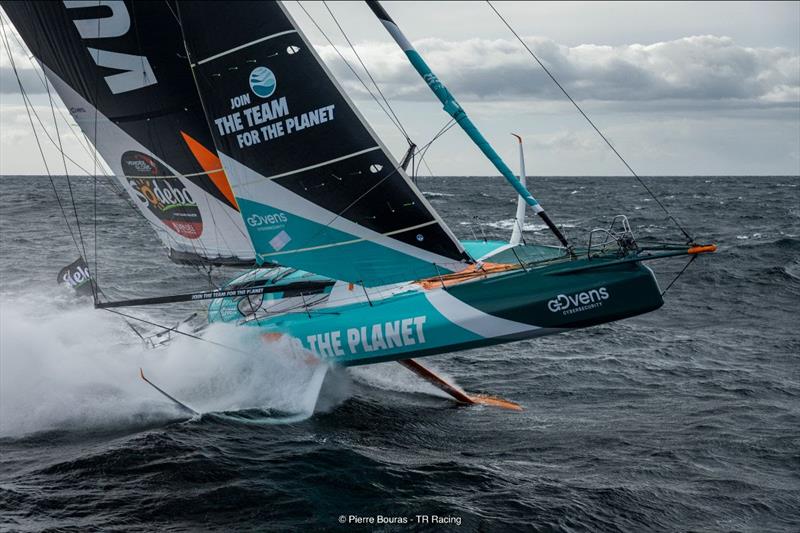
Vendee Globe - Day 8 - Fleet now moving - but Doldrums beckon
by Richard Gladwell, Sail-World NZ 19 Nov 2024 04:32 NZDT
16-17 November 2024

Sam Goodchild - Vendée Globe © Pierre Bouras / TR Racing
After several days enduring an unseasonal patch of light airs, the 38 boat Vendée Globe Race fleet is on the move at varying speeds. Only a handful of the IMOCA60s are turning in double figure VMG (Velocity Made Good) speeds, and the top VMG over 24hrs was 12.7kts recorded by Nicholas Lunven (Holcim PRB).
The significance of that statistic is that while the fleet are pleased to be moving no-one is making a race winning break on the fleet.
Ahead lies the zone known to sailors of old as "The Doldrums" and to the meteorologically inclined as the "Intertropical Convergence Zone. There the race may restart yet again.
We can see the ITCZ lying in wait on the weather routing from Predictwind. Vendée Globe race control say the fleet is expected to hit the Doldrums
in 24hours or so. That assumes they exist in a year of unseasonal weather.
A flick back through accounts of previous Run the World races reveals race boats pass through the area in 25-30kt winds, others make the transition from the supposed trade winds of the Northern Hemisphere to those of the Southern Hemisphere in just eight hours, others ghost along for days.
In a non-stop race like the Vendée Globe this is the first real opportunity to get a race winning break.
The fleet is still split into two or three groups with a distance of 800nm covering the face of the fleet.
The course Predictwind Weather Routing which takes up to six customised feeds and uses those to select the optimum course for the boat, using a polar performance chart to select point of sailing to get to the next waypoint in the shortest time.
Vendée Globe Race uses a different method - measuring the distance left to sail in the race by each competitor, and the one with the shortest distance wins. In other round the world races , that method has been proven to be a flawed method of predicting a winning boat, or best course.
As can be seen from the routing diagrams, there are two options at play - depending where a competitor has elected to position themselves over the first week of the race - which has been marked by light weather.
Jean Le Cam has been scored as the race leader for several days. The oldest competitor in the fleet, sailing a dagger board fitted IMOCA60 decided to go east, almost right to the African coast, and has been sailing own the edge of the Sahara desert. Le Cam, along with New Zealand USA sailor Conrad Colman, who is even further inshore - have only one option. They now have to keep sailing due south, pass through the Exclusion Zones of Mauritania and Cape Verdes Islands and hope they can break through the Doldrums and then sail in the available breeze - only about 12kts, before hitting a stronger breeze.
The weather routing isn't very kind to either of them predicting they will take 19-20 days to reach the entrance to the Ice Gate off the Cape of Good Hope. However the weather data can and doe change and there is still over 4,000nm to sail on the first "leg" to the bottom of South Africa.
The other group led by race leader (on both systems), Paul Goodchild, are more into the centre and sail go west aiming for Fortaleza on the Brazilian coast before getting into the tradewinds around the South Atlantic High and sailing fast for the Southern Ocean. He is predicted to get to the entrance to the Ice Gate Zone in 12-14 days.
The Ice Gate is now shown on the Predictwind Routing. It runs around the perimeter of the Southern Ocean, and it is a safety measure to keep out of the deep southern ocean. Most will sail close to the Ice Gate, so they sail the shortest allowed distance on this part of the course.